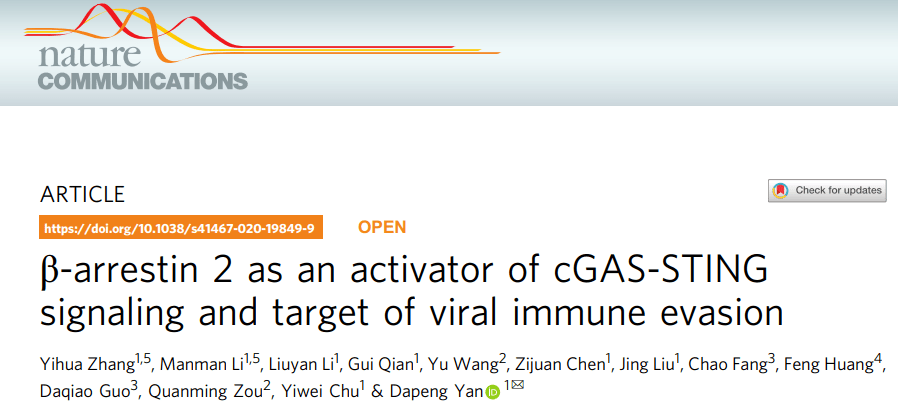A new mechanism for virus immune escape
- Normal Liver Cells Found to Promote Cancer Metastasis to the Liver
- Nearly 80% Complete Remission: Breakthrough in ADC Anti-Tumor Treatment
- Vaccination Against Common Diseases May Prevent Dementia!
- New Alzheimer’s Disease (AD) Diagnosis and Staging Criteria
- Breakthrough in Alzheimer’s Disease: New Nasal Spray Halts Cognitive Decline by Targeting Toxic Protein
- Can the Tap Water at the Paris Olympics be Drunk Directly?
A new mechanism for virus immune escape
A new mechanism for virus immune escape. A research team from China Fudan University School of Medicine discovered a new mechanism for virus immune escape.
The human immune response includes innate immunity and adaptive immunity. When a pathogen invades the host, it first initiates an innate immune response. Among them, type I interferon and its regulated signal pathway play a major role in antiviral immunity.
IFNβ can activate the JAK-STAT pathway and promote the expression of a large number of inflammatory factors such as TNFα and IL-6, thereby initiating the body’s antiviral immune response.

Recently, Dapeng Yan’s team from the Department of Immunology, School of Basic Medicine, Fudan University published a research paper titled β-arrestin 2 as an activator of cGAS-STING signaling and target of viral immune evasion in Nature communications.
This study revealed that β-arrestin 2 regulates the molecular mechanism of type I interferon pathway through cGAS, and the virus achieves its immune escape by degrading β-arrestin 2.
Yan Dapeng’s group found that β-arrestin 2 promotes the expression of IFNβ, the activation of type I interferon signaling pathway and the antiviral immunity of mice. In mechanism, β-arrestin 2 directly binds to cGAS and promotes the combination of cGAS and DNA and the production of cGAMP. The deacetylation of β-arrestin 2 in infection is the basis for its anti-infective function. In the early stage of viral infection, β-arrestin 2 is rapidly deacetylated and activated to exert its anti-infective function; while in the late stage of infection, β-arrestin 2 can be induced by the virus, ubiquitinated and degraded, helping the virus to achieve immunity escape.
However, the magic is one foot high, and the road is high. Further studies have found that the anti-heart failure drug Carvedilol can promote the deacetylation of β-arrestin 2 and inhibit the degradation of β-arrestin 2, and regulate type I by stabilizing β-arrestin 2 The interferon signaling pathway and the antiviral immunity of mice suggest that it can be used as a potential antiviral drug.
Researchers found that during viral infection β-arrestin 2 can promote the expression of IFNβ and the phosphorylation of key proteins TBK1, IRF3, IRF7, STING in the type I interferon signaling pathway, and the phosphorylation of P65, P38, JNK, ERK The level has no effect, which means that β-arrestin 2 mainly acts on the type I interferon signaling pathway during viral infection.
At the same time, the antiviral response of Arrb 2 -/- mice was significantly weaker than that of wild-type mice. In order to further clarify the mechanism of β-arrestin 2 regulating the type I interferon signaling pathway, the researchers found that β-arrestin 2 can directly bind to cGAS through immunoprecipitation and GST-pull down experiments.
As a signal sensor, cGAS can recognize double-stranded DNA and change its own conformation during virus infection, thereby promoting the synthesis of AMP and GMP into cGAMP, which can be recognized by STING, thereby activating downstream signaling pathways. The researchers found that β-arrestin 2 can not only promote the recognition of DNA by cGAS, but also promote the production of cGAMP, and promote the activation of downstream signal pathways.
Interestingly, viral infection can degrade β-arrestin 2. The researchers screened an interesting site by mass spectrometry—Lysine 171 (Lys171). This site can be both acetylated and ubiquitinated. In order to explore the effects of acetylation and ubiquitination on β-arrestin 2 function, the researchers constructed two point mutations K171R (no acetylation and no ubiquitination) and K171Q (simulating the state of continuous acetylation).
The results showed that K171R further promoted the expression of IFNβ, the activation of type I interferon signaling pathway and the function of cGAS, while K171Q completely lost β-arrestin 2’s function during viral infection. It can be seen that the deacetylation of β-arrestin 2 lysine at position 171 is a prerequisite for its function.
More interestingly, the point mutations K171R and K171Q of β-arrestin 2 did not degrade during infection, indicating that lysine 171 may also be the key site for β-arrestin 2 degradation.
In order to further clarify the mutual regulation of deacetylation and ubiquitination, the researchers tested the ubiquitination and deacetylation levels of β-arrestin 2 in different time periods, and found that β-arrestin 2 was already in the early stage of infection (1 hour) A very significant deacetylation occurred, and in the late stage of infection (12 hours), β-arrestin 2 began to undergo ubiquitination, and at the same time it also began to degrade.
Therefore, β-arrestin 2 undergoes deacetylation first and then ubiquitination. It is worth mentioning that although β-arrestin 2 is degraded in the later stage of infection, it always maintains low expression and exerts antiviral function.
(source:internet, reference only)
Disclaimer of medicaltrend.org



